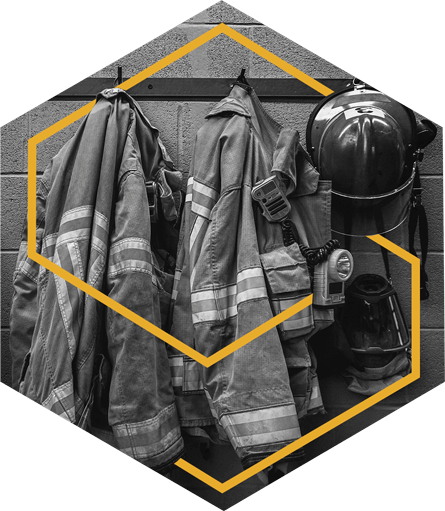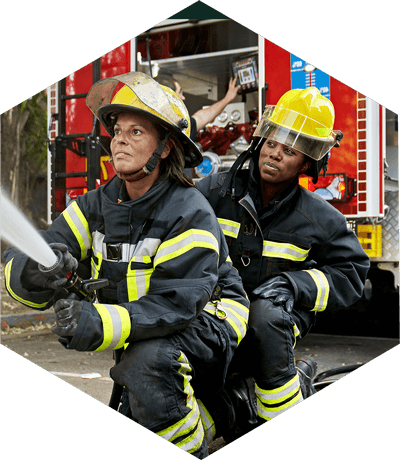
Understanding the Risks of Forever Chemicals
Occupational cancer is the number one cause of line-of-duty deaths for fire fighters. Exposure to dangerous forever chemicals like PFAS has been shown to cause cancers.

What Are PFAS?
PFAS (per- and polyfluoroalkyl substances) include more than 12,000 synthetic chemicals not found in nature. They’re often referred to as “forever chemicals” given their persistence in the environment and human body.
PFAS have been used in fire fighting foam and turnout gear for decades. All three layers of fire fighter turnout gear contain PFAS and pose an occupational risk of illness.
Studies link PFAS exposure to the development of serious health effects, including cancer, behavioral development, metabolic, circulatory, digestive, endocrine, immune, neurological and reproductive system problems.
PFAS in Turnout Gear
Because of the toxic nature of PFAS, bunker gear can put members at unnecessary risk — yet until recent and significant revisions to the National Fire Protection Association’s (NFPA) standards on structural and proximity firefighting, PFAS materials were effectively required in U.S. and Canadian fire fighter turnout gear to satisfy a stringent UV light degradation test. The UV light test introduced in 2007 effectively required the use of PFAS materials in the moisture barriers of fire fighter PPE, making it difficult to transition to PFAS-free alternatives as no other materials could satisfy the 40 hour light exposure criteria in the standard.
The NFPA Standard 1971 Section 8.62 required bunker gear to pass a 40-hour ultraviolet light degradation test, which effectively necessitated the use of PFAS in turnout gear, because no other materials could pass this stringent test. This specific requirement was stopping fire departments from utilizing PPE that doesn’t contain forever chemicals.
The PFAS Law Firms were at the forefront of the fight to change this to keep IAFF members safe. On March 16, 2023, we sued the NFPA on behalf of the IAFF seeking change to the regulatory standards and systems. In October 2024, a new consolidated standard was introduced.
This represents a significant step toward addressing concerns related to PFAS in fire fighter gear.
Changes in the 2025 edition created a list of restricted substances for manufacturers and removed the moisture barrier UV light degradation test, which had effectively required the use of toxic PFAS in bunker gear.
PFAS in Fire Fighting Foam
Fire fighters are exposed to PFAS when using Aqueous Film-Forming Foam (AFFF) to suppress high-intensity and liquid fuel fires. Exposure to PFAS chemicals is linked to serious health risks, including various diseases and cancers. These chemicals have harmed fire fighters, military personnel, first responders, and entire communities who were unknowingly exposed through contaminated groundwater, workplace exposure or other means.
The claims related to AFFF have been consolidated under the In re: Aqueous Film-Forming Foams (AFFF) Products Liability Litigation (MDL No. 2873) in the U.S. District Court for the District of South Carolina. If you were exposed to AFFF and later developed kidney (renal) cancer, testicular cancer, liver cancer, thyroid cancer or thyroid disease, you may be eligible to file a lawsuit.

What Kinds of Disease Are Caused by PFAS?
PFAS have been linked to several serious diseases. We are currently accepting cases related to these:
- Kidney Cancer (renal)
- Liver Cancer
- Thyroid Cancer
- Thyroid Disease
- Testicular Cancer
- Ulcerative Colitis
What Is the IAFF Doing About PFAS?
The IAFF took on the fight, filed a lawsuit against the NFPA, and created a pathway for PFAS-free turnout gear. The IAFF is also lobbying Congress and the Trump administration to provide funds and resources to develop next-generation, PFAS-free gear and support fire fighters.
The PFAS Law Firms were at the forefront of the fight to change this to keep IAFF members safe. On March 16, 2023, we filed a lawsuit against the NFPA on behalf of the IAFF to seek change to the NFPA standards.
How to Limit PFAS Exposure
The time has long passed for occupational cancer to be an acceptable “part of the job.” The IAFF encourages all fire fighters to do what they can to limit and minimize exposure to the extent possible, by doing the following:
- Keep gear in a sealed container or bag during transport
- Clean apparatus cabs regularly after every fire
- Wash your hands after handling turnout gear
- Replace legacy gear with PFAS-free options once available
- Use only for its intended design combatting structural or proximity fires
- Help spread the message at your Local level
Our three firms are available to provide legal representation to pursue compensation on behalf of qualified fire fighters with cancer.
Secure Submission
Frequently Asked Questions
Why does turnout gear contain PFAS?
PFAS are a major constituent of the moisture barrier, and they have been used in durable water repellent (DWR) finishes that provide water and oil repellency which have been applied to the outer shell, some thermal liners, and portions of the moisture barrier laminate.
Changes in the 2025 edition of the NFPA standard creates a list of restricted substances for manufacturers and removes the moisture barrier UV light degradation test, which had effectively required the use of toxic PFAS in bunker gear.
Section 8.62 of NFPA Standard 1971 requires a light degradation resistance test for moisture barrier materials, which is preventing PFAS-free moisture barrier alternatives from coming to market.
Is PFAS-free gear ready?
Next-generation, PFAS-free gear is in all stages of research, development, and manufacturing.
Who can file a PFAS lawsuit?
Fire fighters who have been diagnosed with the listed diseases or immediate family members of deceased loved ones may be eligible to file a PFAS lawsuit. The time to file a claim is limited, so acting quickly is critical.
If you delay, any rights you may have may be forever lost.
What can be done at the local level to prevent exposure?
Local as well as state/provincial health and safety and wellness/fitness committees should help spread the message of the PFAS Joint Statement, including the precautionary recommendations. Local leadership should also encourage members not to use turnout gear other than for the specific hazards it is designed to protect from.
The IAFF Government Affairs Department has assisted several state affiliates in developing state-level legislation to ban PFAS-laden fire fighting foams, require PFAS-awareness labels on new bunker gear, and share points that can hopefully limit fire fighters’ exposures to PFAS.
Any affiliate interested in developing and promoting similar legislation in their state is encouraged to contact the IAFF Government Affairs Department for assistance.
